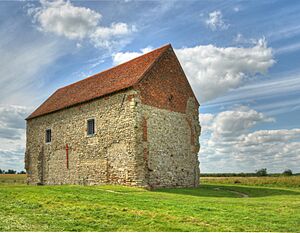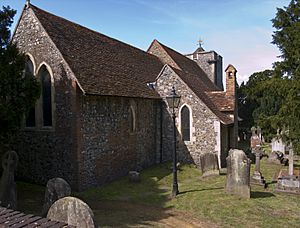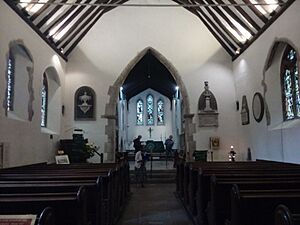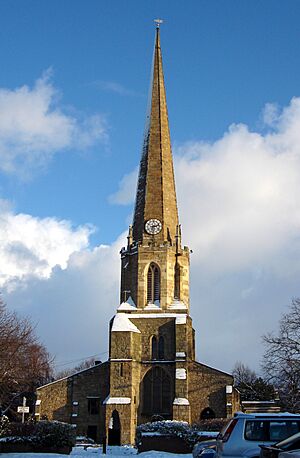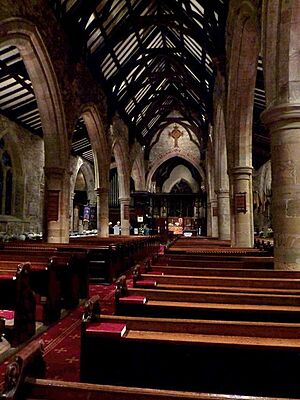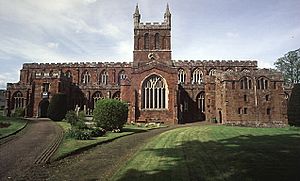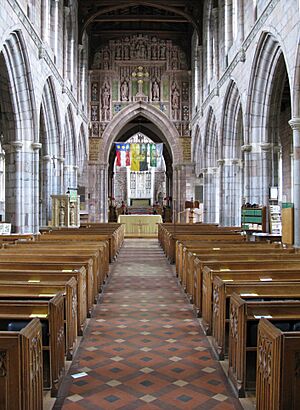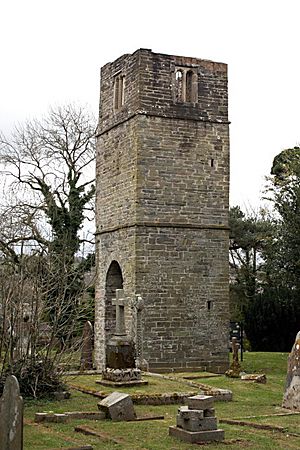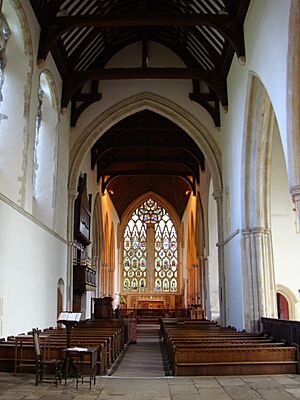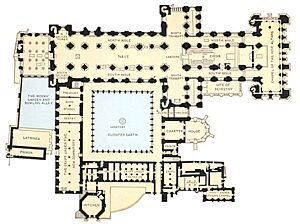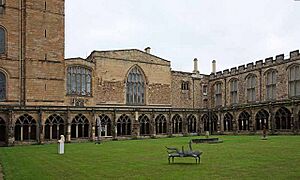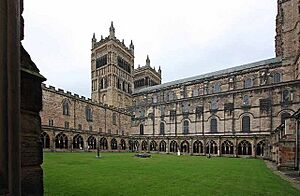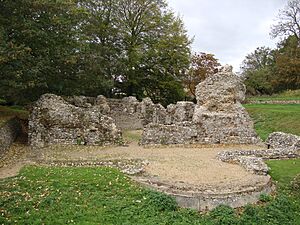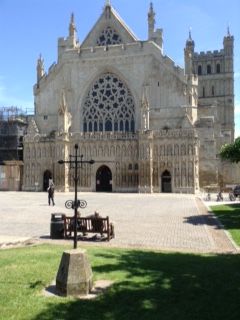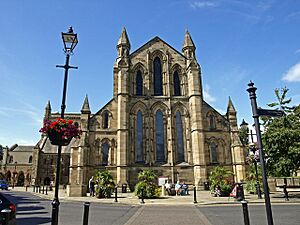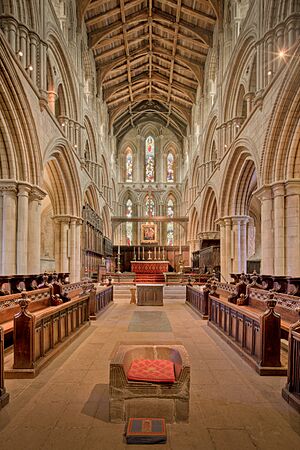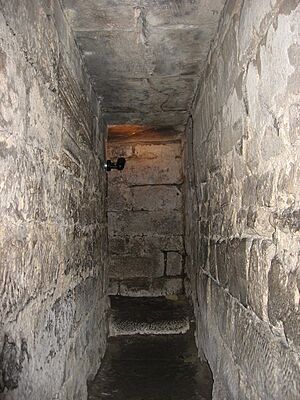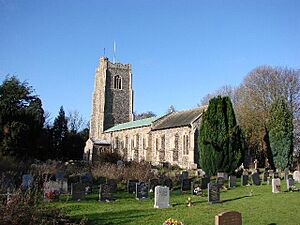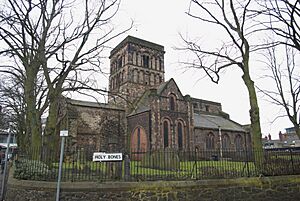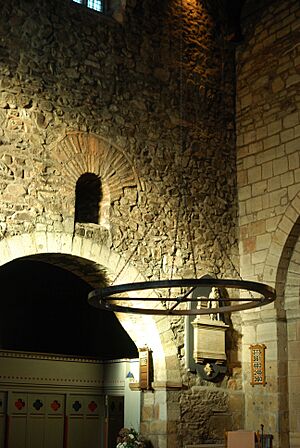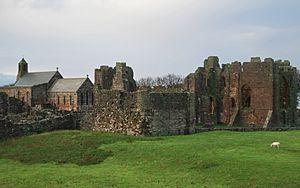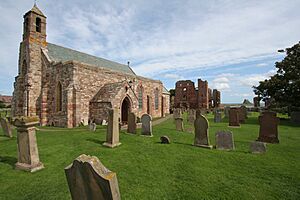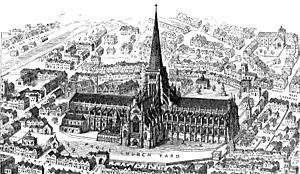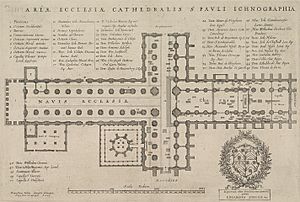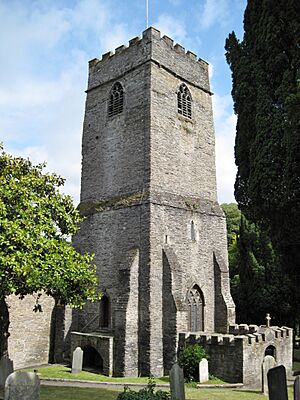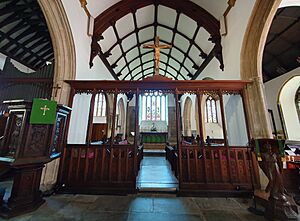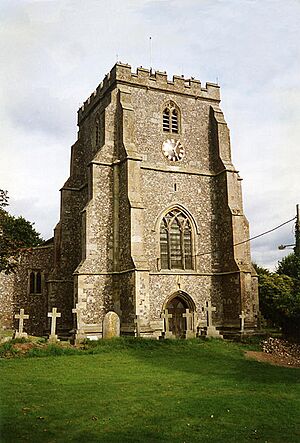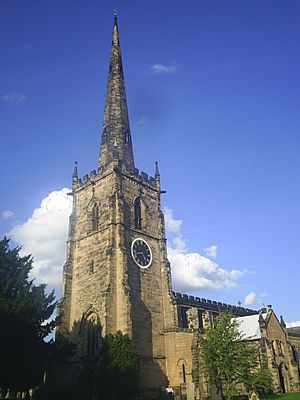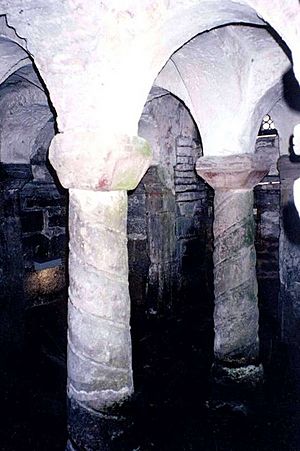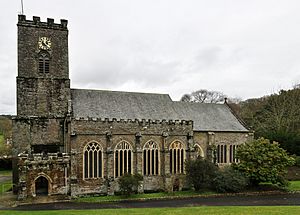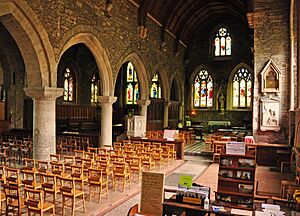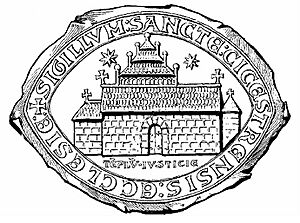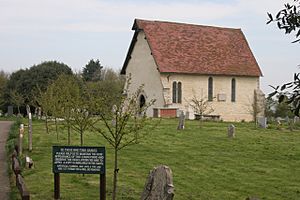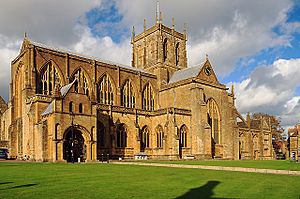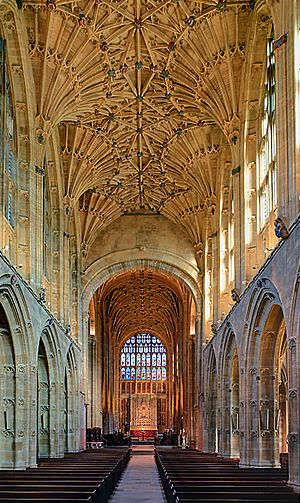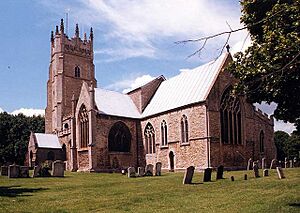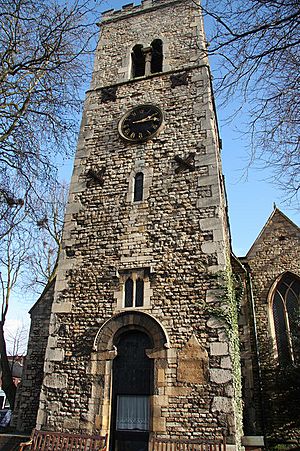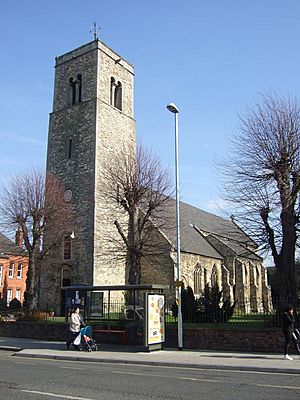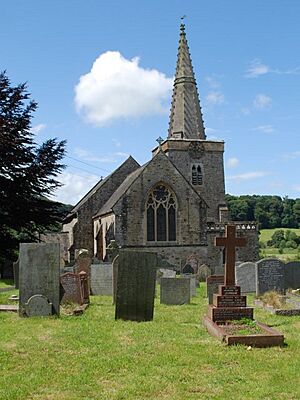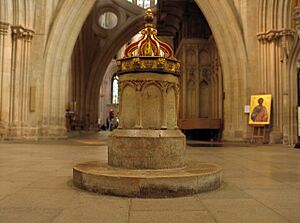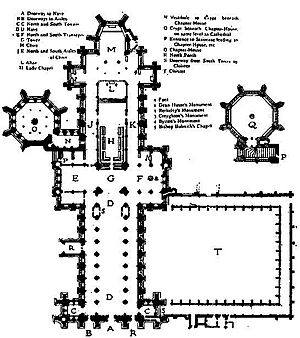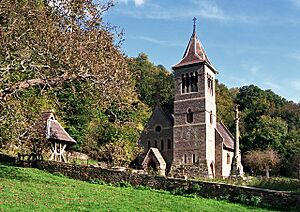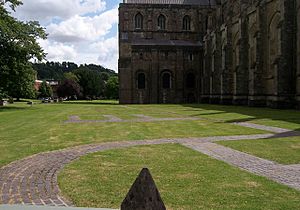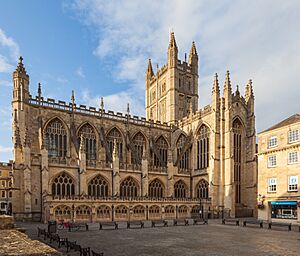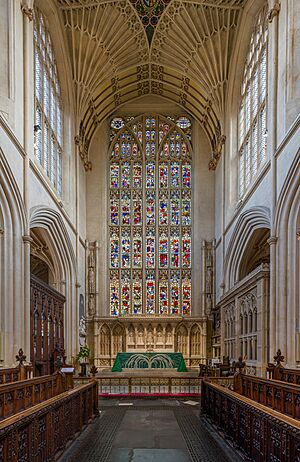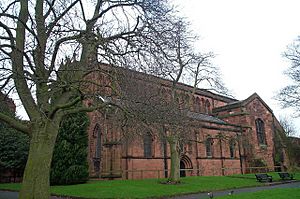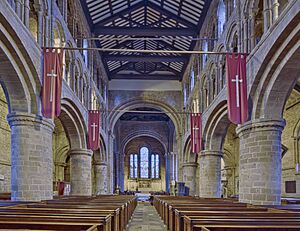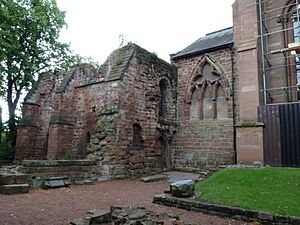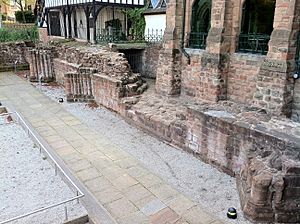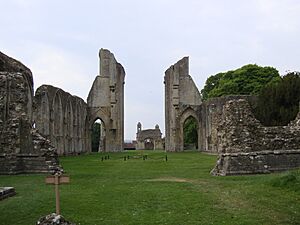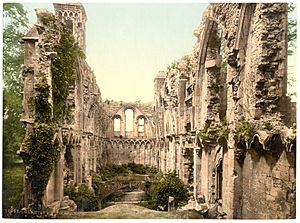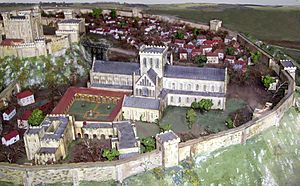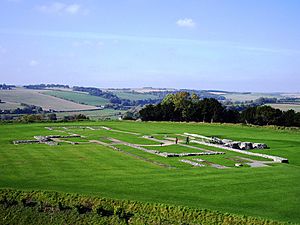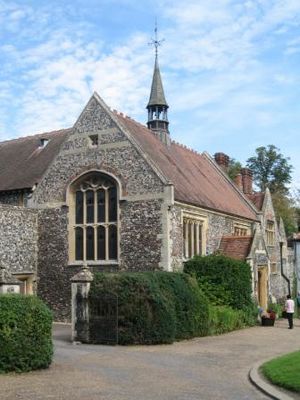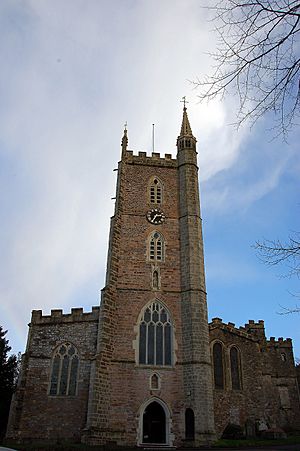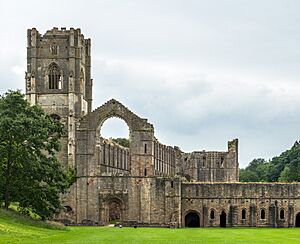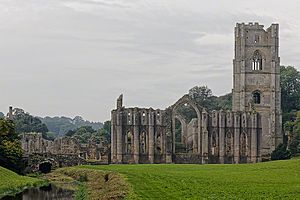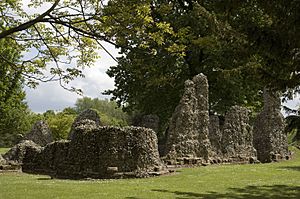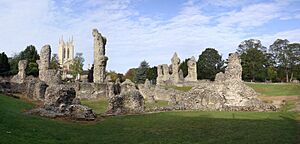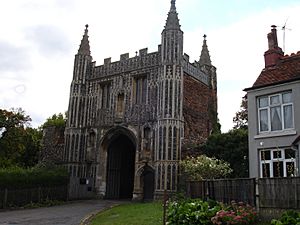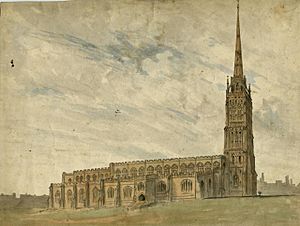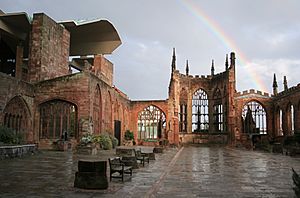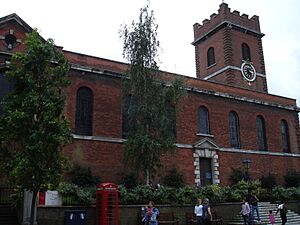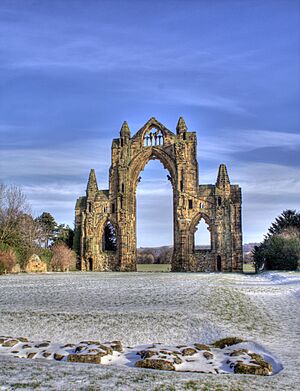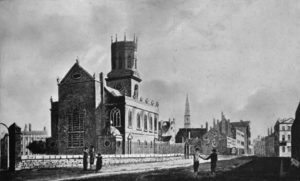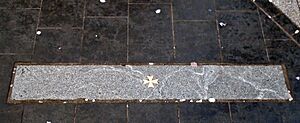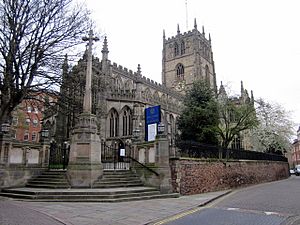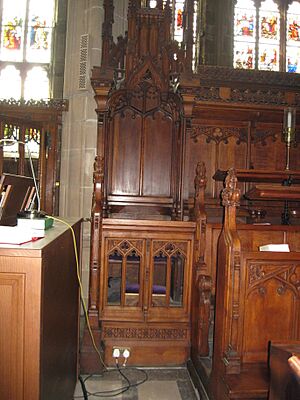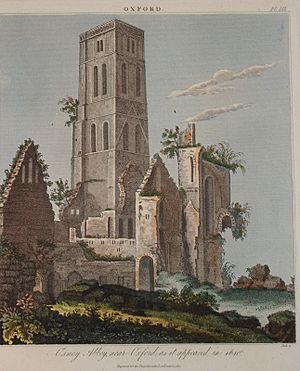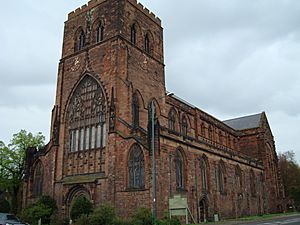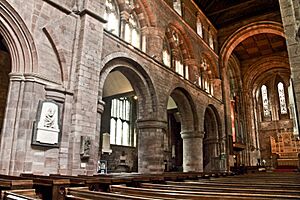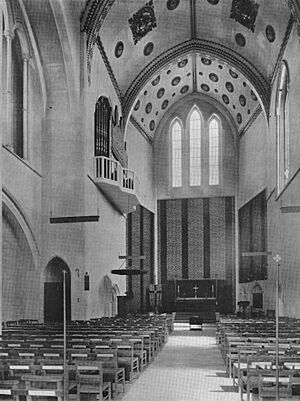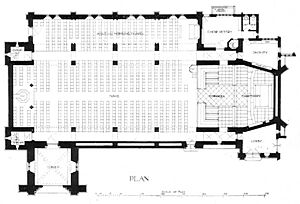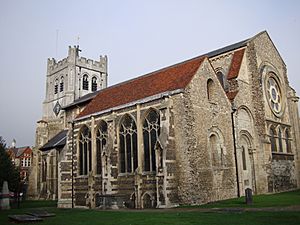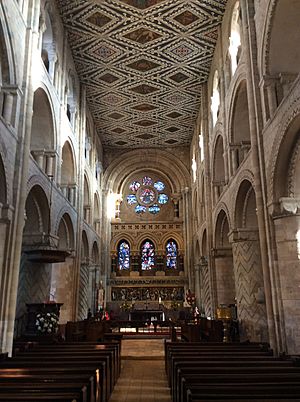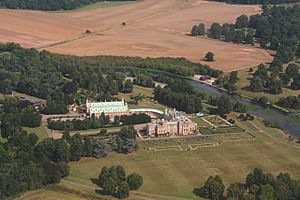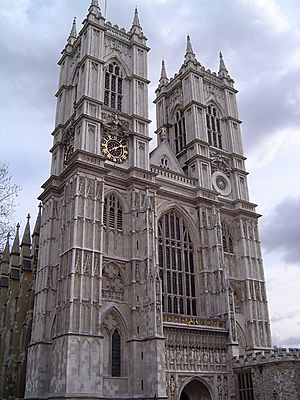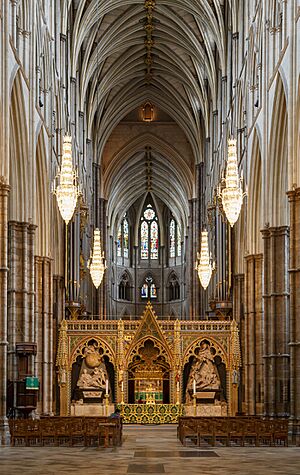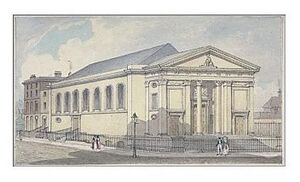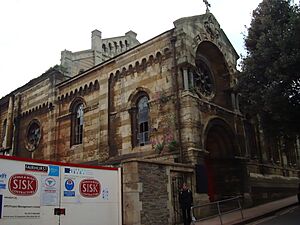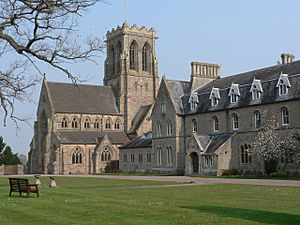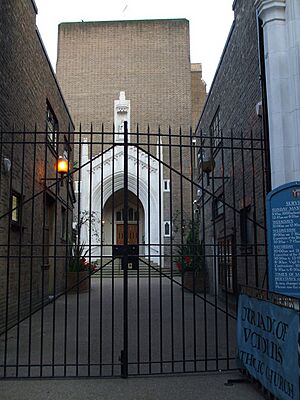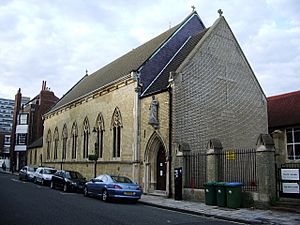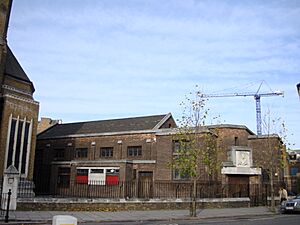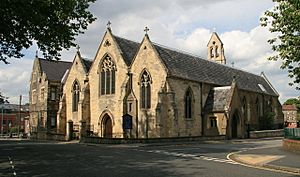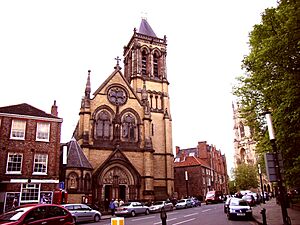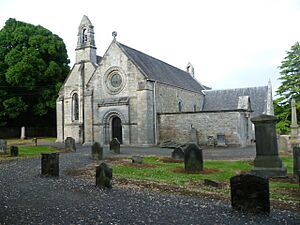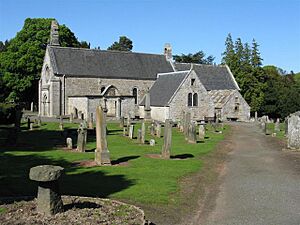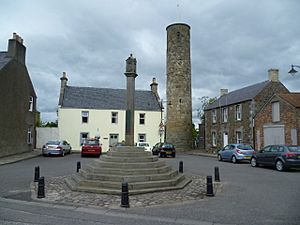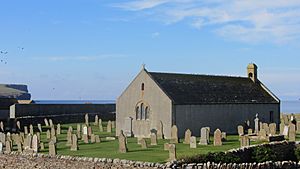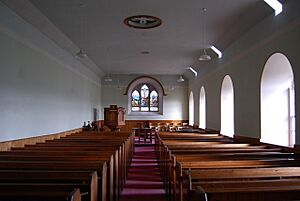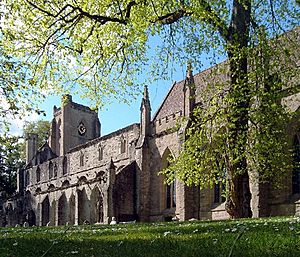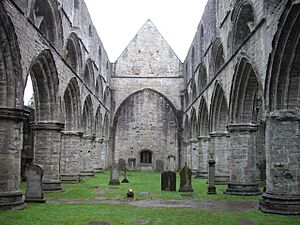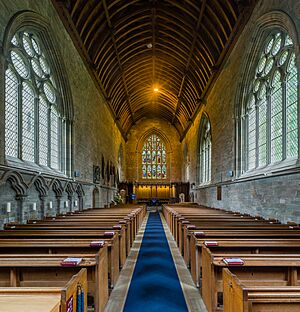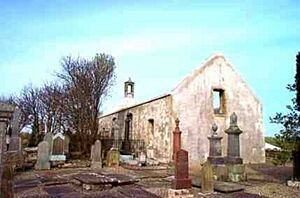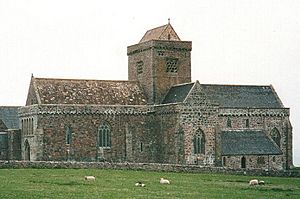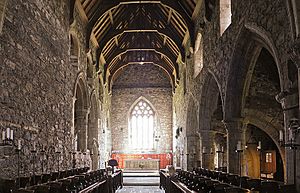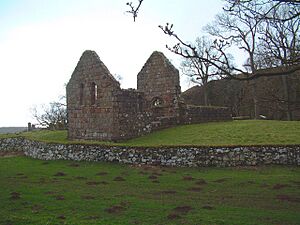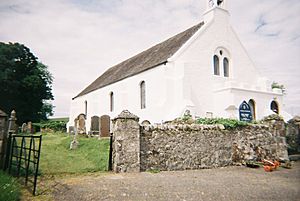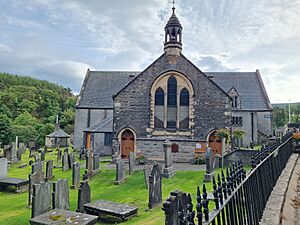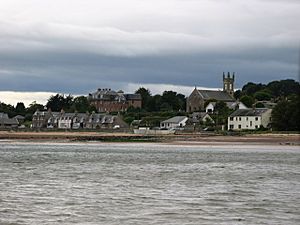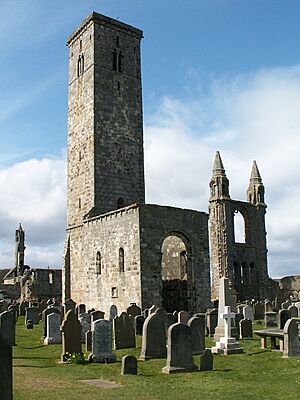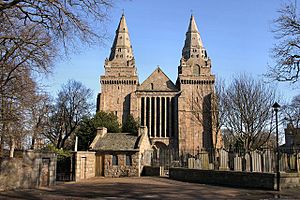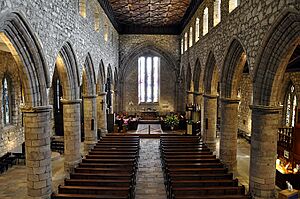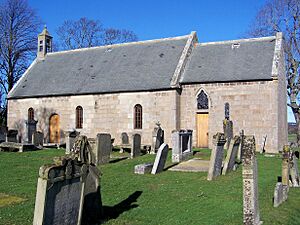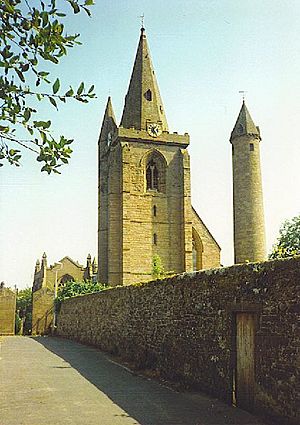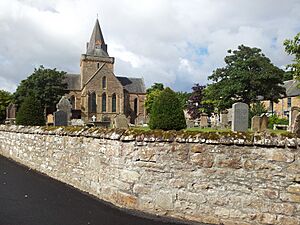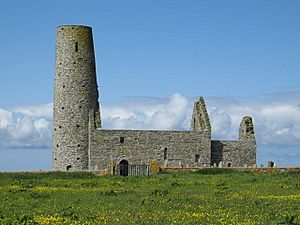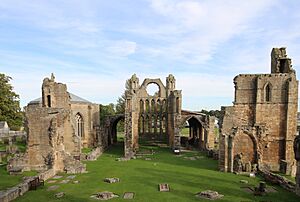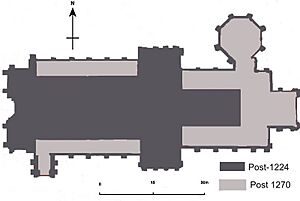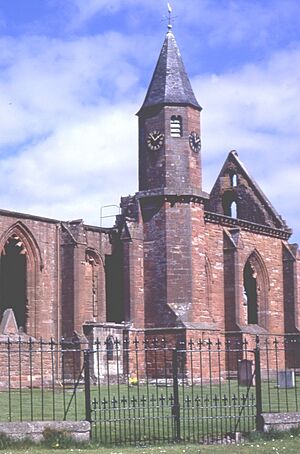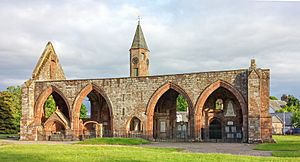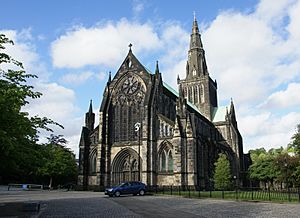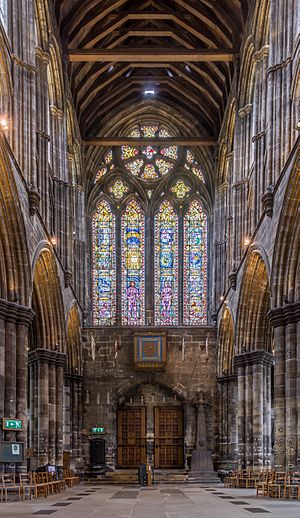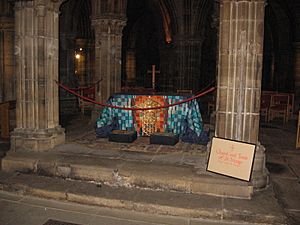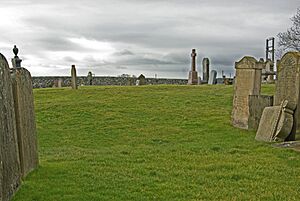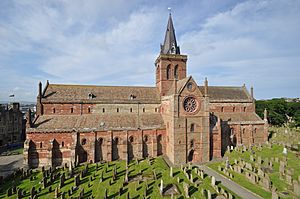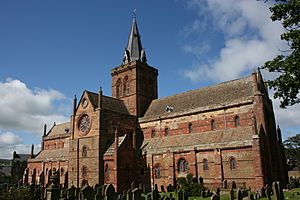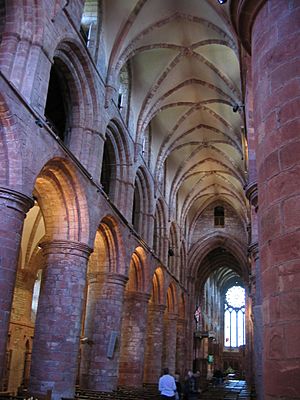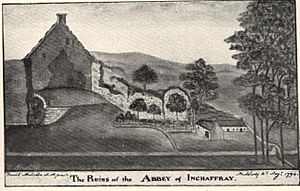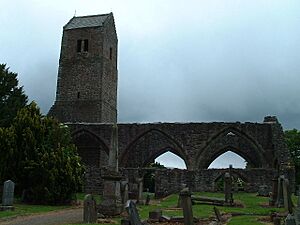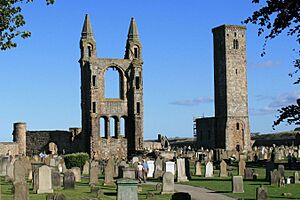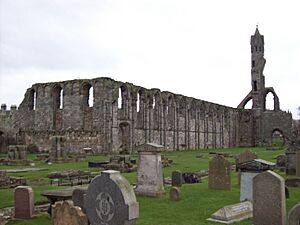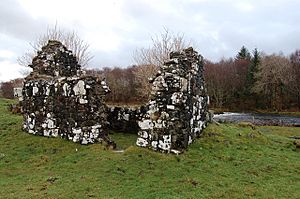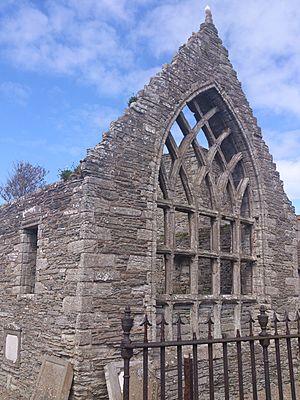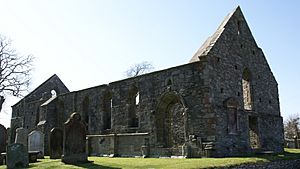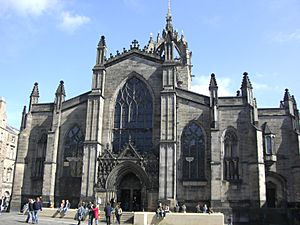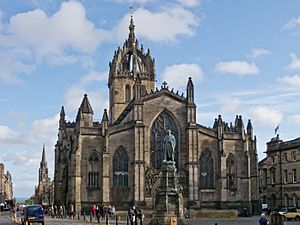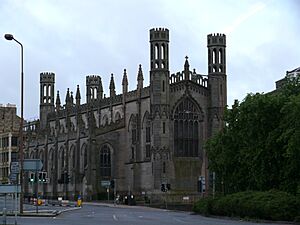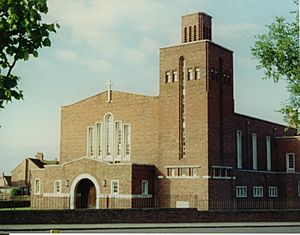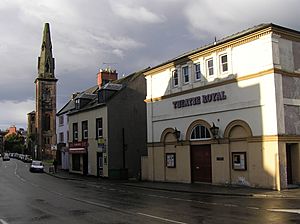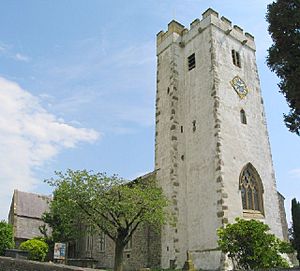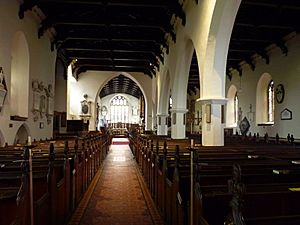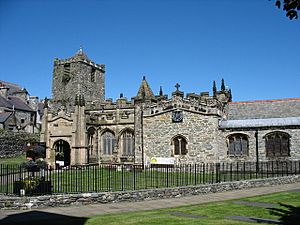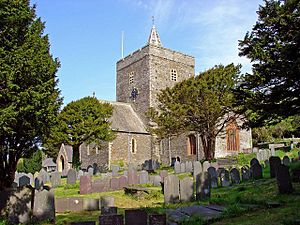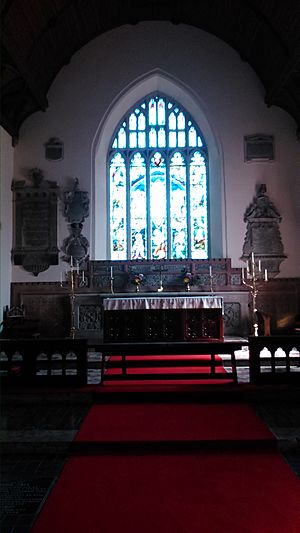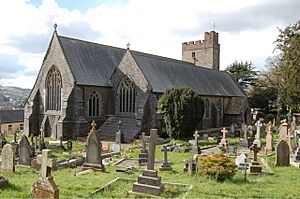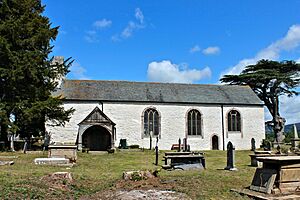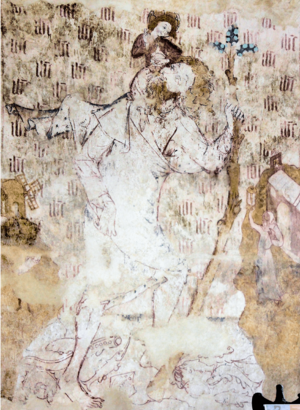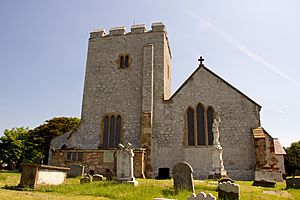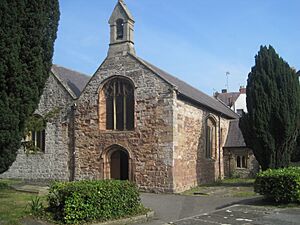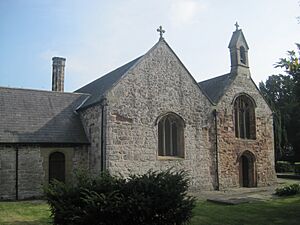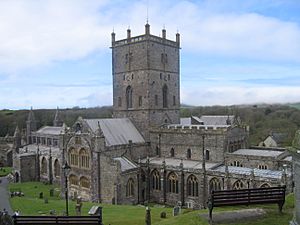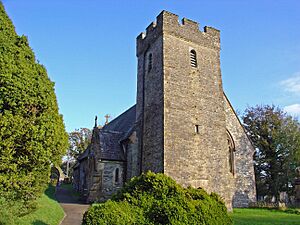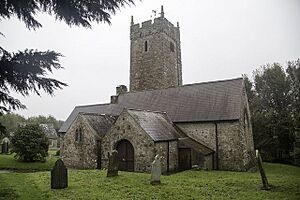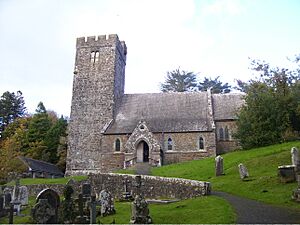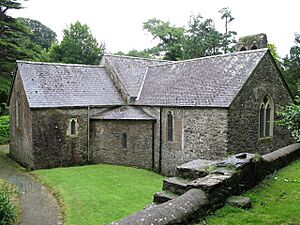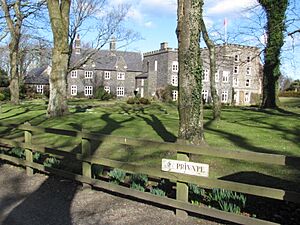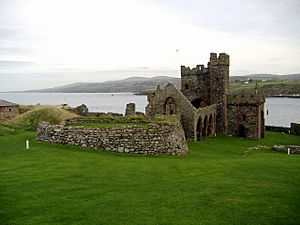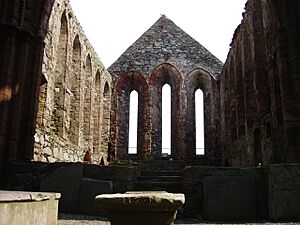List of former cathedrals in Great Britain facts for kids
A cathedral is a very important church that serves as the main church for a bishop. A bishop is a leader in the Christian church. This list is about churches in Great Britain that used to be cathedrals but aren't anymore. It also includes churches that were planned to be cathedrals but never became one.
Sometimes, a church stops being a cathedral because the bishop's main office moved to a different place. Or maybe a new, bigger cathedral was built nearby, and the old one was used for other things or even taken down. This list includes all these kinds of former cathedrals.
A pro-cathedral is a church that was used as a temporary cathedral until a new, permanent one was ready. You'll find some of those here too!
If a church was only proposed to be a cathedral but it never happened, it's also on this list.
If you want to learn about churches that are *currently* cathedrals in Great Britain, you can check out these lists:
- List of cathedrals in England
- List of cathedrals in Scotland
- List of cathedrals in Wales
Contents
England's Former Cathedrals
This section looks at churches in England that used to be cathedrals. We'll see what they are used for now, or what they were used for before they stopped being churches.
Churches that were Cathedrals Before 1066
These churches were cathedrals a very long time ago, before the Norman Conquest of England in 1066. Many of them later became part of the Church of England around 1540 during the English Reformation.
| Location | Image | Name | Dates as Cathedral | What Happened? |
|---|---|---|---|---|
| Bradwell-on-Sea, Essex | Chapel of St Peter-on-the-Wall | 654 – 664 | This church was built by Cedd in 653. He used old Roman materials. Cedd died in 664, and the church stopped being a cathedral. For a long time, it was even used as a barn! It was fixed up and became a church again in 1920 and is still used regularly. | |
| Canterbury, Kent | St Martin's Church, Canterbury | 597 – 602 | This church is thought to be the oldest church in England that's been used continuously. When St Augustine arrived in 597, he used it as his first cathedral while a new one was being built. Since then, it has been a local parish church. | |
| Chester-le-Street, County Durham | Collegiate Church of St Mary and St Cuthbert | c. 883 – c. 995 | Monks carrying the body of St Cuthbert settled here in 883 after fleeing Lindisfarne from Viking raids. They built a wooden church for Cuthbert's relics and the bishop's chair. In 995, they moved again to Durham. The current church was built on the same spot. | |
| Crediton, Devon | Collegiate Church of the Holy Cross and the Mother of Him Who Hung Thereon | 909 – 1050 | A new bishop's area for Devon and Cornwall was created here in 909. The cathedral of St Mary was replaced when the bishop's main office moved to Exeter in 1050. A new church, now called the Holy Cross, was built on the same site. | |
| Dinuurrin, (Bodmin), Cornwall | Site uncertain; dedication unknown | 9th century | This was the seat of an early Cornish bishop named Kenstec. The exact spot is not known for sure, but it's believed to be on high ground in Bodmin. Only the ruins of a tower, called "Berry Tower," remain from a later chapel on the site. | |
| Dorchester on Thames, Oxfordshire | Abbey Church of St Peter & St Paul, Dorchester | 635 – c. 660; then c. 675 – 737; and c. 875 – 1072 | This was the first bishop's seat for the West Saxons. It moved to Winchester around 660. It became a bishopric again twice for the Mercians. Finally, the bishop's seat moved to Lincoln in 1072. The church is now a parish church. | |
| Durham, County Durham | The White Church (Alba Ecclesia) (likely dedicated to St Cuthbert) | c. 998 – c. 1104 | Monks carrying St Cuthbert's body settled in Durham in 995. They built a stone church, known as "The White Church," to house his relics. This church was taken down in 1104 when the new, larger Durham Cathedral was being built. Its old foundations are under the cloisters of the current cathedral. | |
| Elmham, Norfolk | Dedication unknown | 673 – c. 850; and c. 950 - 1071 | The bishop's seat for East Anglia was divided in 673, and Elmham became one of the new centers. Viking raids stopped it from being a bishopric around 850, but it was restored around 950. In 1071, the bishop's seat moved to Thetford. Only church ruins remain today. | |
| Exeter, Devon | Church of St Mary Major, Exeter; status uncertain | 1050 – c.1133 | This church became the bishop's seat when the Crediton bishopric moved to Exeter in 1050. A new Norman cathedral was started nearby in 1114. St Mary's became a parish church and was later demolished in 1865. A stone finial (top part of a spire) from its replacement church is on the cathedral green. | |
| Hexham, Northumberland | Priory and Parish Church of St Andrew, Hexham | 678 – c. 821 | This abbey was founded by Wilfrid in 674. In 678, it became a bishop's seat. The bishopric ended in 821, and the abbey was destroyed by Danes in 875. Later, a priory was built on the site. Today, it's a parish church, and you can still see St Wilfrid's 7th-century crypt. | |
| Hoxne, Suffolk | Church of St Peter and St Paul, with St Edmund; status uncertain | c. 926 – c. 952 or later | In 926, the Bishop of London, Theodred, also became responsible for Suffolk and Norfolk and set up a new bishop's seat here. This was because the older East Anglian bishoprics had stopped working due to Viking attacks. The church remained important even after Theodred's death. | |
| Leicester, Leicestershire | St Nicholas' Church, Leicester; site probable; original dedication unknown | 679 – 874? | Leicester became a bishopric in 679. The church of St Nicholas, with its old Anglo-Saxon parts, is likely the site of the original cathedral. It was taken over by Danes around 875 and merged with Dorchester on Thames. St Nicholas' is now a parish church. | |
| Lindisfarne, Northumberland | Church of St Mary the Virgin, Lindisfarne; original dedication unknown | 635 – 875 | A monastery was founded here in 635 by King Oswald for St Aidan to be the main church for northern Northumbria. Viking raids led to its destruction in 875. The monks fled with St Cuthbert's relics. The parish church of St Mary the Virgin stands near the ruins of the priory. | |
| London (City of), London | Old St Paul's Cathedral, London | 604 – 1666 | This was a huge cathedral built by the Normans, following earlier Anglo-Saxon churches. It was destroyed by the Great Fire of London in 1666. The current St Paul's Cathedral was built on a slightly different spot. | |
| Padstow, Cornwall | St Petroc's Church | 518 - 564? | Tradition says Saint Petroc landed near here in 518 and founded a monastery. Its church became Petroc's cathedral for Cornwall. After a Viking attack in 981, the monks moved to Bodmin. The current parish church is believed to be on the original monastic site. | |
| Ramsbury, Wiltshire | Church of the Holy Cross, Ramsbury; site probable; original dedication unknown | 909 – 1058 | The Ramsbury bishopric was created in 909. In 1058, it joined with the Diocese of Sherborne to form the Diocese of Salisbury. The former Ramsbury Cathedral is thought to be where the Holy Cross parish church stands today. | |
| Repton, Derbyshire | St Wystan's church; original dedication uncertain | c. 655 – 669 | This monastery was supposedly the first bishop's seat for Mercia. The bishop's seat moved to Lichfield in 669. The monastery was destroyed by Danes, but its 8th-century crypt survived and was used for royal burials. It's now a parish church. | |
| St Germans, Cornwall | Priory Church of St Germanus | early 10th century – c. 1027 | King Athelstan appointed Conan as Bishop of Cornwall around 936, with his main church here. The bishop's seat later moved to Crediton around 1027. The church became a priory and is now a parish church with some old Norman parts. | |
| Selsey, Sussex | Selsey Abbey; site uncertain; dedication unclear | c. 681 – c.1075 | King Æthelwealh helped Wilfrid found a monastery and bishopric here. The bishop's seat moved to Chichester around 1075. Coastal erosion means the original site might be under the sea, but the 13th-century St Wilfrid's Chapel, Church Norton is the most likely spot. | |
| Sherborne, Dorset | Abbey Church of St Mary the Virgin | 705 – 1075 | This bishop's seat was created in 705 for western Wessex. In 909, new bishoprics were created, leaving Sherborne with only Dorset. The bishop's seat moved to Old Sarum in 1075. Sherborne became an abbey and is now the town's parish church. | |
| Soham, Cambridgeshire | St Andrew's Church, Soham; status uncertain | c. 630?; and c. 900 – c. 950 | A monastery here, possibly founded by St Felix, might have been an early cathedral for East Anglia. It was destroyed by Danes but rebuilt around 900 and may have served as a cathedral again. Ancient parts remain in St Andrew's parish church. | |
| Syddensis, Lindsey, Lincolnshire | Site uncertain; original dedication unknown | c. 680 – c. 875 | A cathedral was built in Lindsey for the Bishop of Lindsey around 680. The exact location is unknown, but it might have been in Lincoln, possibly at St Mary-le-Wigford or St Peter-at-Gowts. The bishop's seat moved to Dorchester-on-Thames due to Danish invasions. | |
| Tawton, (later Bishop's Tawton), Devon | A Church of St Peter was recorded in 1256; later, Church of St John the Baptist; status doubtful | c. 905 – c.909 | Some old records suggest this was the first bishop's seat for Devon. The bishop's seat quickly moved to Crediton. The current parish church of St John the Baptist is on or near the ancient site. | |
| Wells, Somerset | Minster Church of St Andrew | 909 – 1175 | Wells was chosen as the bishop's seat for Somerset in 909. In 1090, a new bishop moved the seat to Bath Abbey. Even though Wells lost its status, a much larger building was started in 1176, which became the basis of the present Wells Cathedral. Wells became a cathedral city again in 1245. | |
| Welsh Bicknor, Herefordshire | St Margaret's Church; site uncertain | 6th century – 8th? century | This area was once part of a British-Welsh kingdom. A British bishop-saint named Dubricius is said to have founded monasteries here, and his main church was identified as Welsh Bicknor. The current church was built in 1858–59 on the site of a much older church. | |
| The Old Minster, Winchester, Hampshire | The Old Minster, Winchester | c. 660 – 1093 | This church was built around 660 as the first bishop's seat for Wessex. It was called "The Old Minster" after a new one was built next to it. It was taken down in 1093 when the new Norman cathedral (the basis of the current Winchester Cathedral) was almost finished. Parts of its foundations are now marked out on the ground. |
Churches that were Cathedrals (or Proposed) Between 1066 and 1539
These churches were cathedrals or planned to be cathedrals after the Norman Conquest but before the English Reformation in 1540.
| Location | Image | Name | Dates as Cathedral | What Happened? |
|---|---|---|---|---|
| Bath, Somerset | Priory Church of St Peter & St Paul | 1090 – 1539 | The bishop's seat for Somerset moved from Wells to Bath in 1090. Bath was a co-cathedral with Glastonbury for a while, then with Wells. When the priory was dissolved in 1539, Queen Elizabeth I gave the church to be Bath's parish church. | |
| Chester, Cheshire | Collegiate Church of St John the Baptist | 1075 – 1102 | This church became the cathedral for the Mercian bishopric when the bishop's seat moved from Lichfield in 1075. The seat moved again to Coventry by 1102. St John's remained an important church. A new Diocese of Chester was created in 1541, using a different church as its cathedral. | |
| Coventry, (Warwickshire), West Midlands | Cathedral Priory of St Mary, St Peter and St Osburga | 1102 – 1539 | This abbey became the bishop's seat for Lichfield around 1102, making it a co-cathedral with Lichfield. The priory church was sold for demolition in 1545 after it was dissolved. Some parts of it have been found and saved. | |
| Glastonbury, Somerset | Abbey Church of St Mary, Glastonbury | 1195 – 1218 | This ancient abbey was briefly a co-cathedral with Bath when the Bishop of Bath was also made Abbot of Glastonbury. The monks disagreed, and the title was changed back in 1218. The abbey was dissolved in 1539, and its stones were taken for other buildings. | |
| Old Sarum, Wiltshire | Old Sarum Cathedral; dedication unknown | 1075 – 1219 | The Normans built a cathedral on this old hillfort site, moving the bishop's seat here from Sherborne in 1075. The seat moved to Salisbury in 1219, and stones from Old Sarum were used to build the new Salisbury Cathedral. Only the foundations remain today. | |
| Thetford, Norfolk | Minster of St Mary Major (St Mary the Great) | 1071 – c. 1094 | The last Bishop of Elmham moved his seat to this church in 1071. The bishop tried to move the seat to Bury St Edmunds Abbey but failed. Around 1094, the bishop's seat moved to Norwich. The site later became a friary, and some remains are part of Thetford Grammar School. | |
| Westbury-on-Trym, Gloucestershire | Holy Trinity Church, Westbury-on-Trym | proposed | This church was founded as a minster around 795. Bishops of Worcester tried to make it a second cathedral in 1286 and again in 1455, but these plans never fully succeeded. |
Former Church of England Cathedrals (or Proposed) from 1540 to Present
These churches were cathedrals or proposed cathedrals after the English Reformation in 1540.
| Location | Image | Name | Dates as Cathedral | What Happened? |
|---|---|---|---|---|
| Aldfield, North Yorkshire | Abbey Church of St Mary, (Fountains Abbey) | proposed | Fountains Abbey was dissolved in 1539. In 1540, King Henry VIII chose its church to be a new cathedral, but the plan was dropped in favor of a new Diocese of Chester. The site is now managed by the National Trust and English Heritage. | |
| Bury St Edmunds, Suffolk | Abbey Church of St Mary & St Edmund | proposed | This abbey was dissolved in 1539. King Henry VIII proposed it as a cathedral in 1540, but the site was sold. The Diocese of St Edmundsbury and Ipswich was eventually created in 1914, with a different church becoming its cathedral. | |
| Colchester, Essex | Abbey Church of St John the Baptist, Colchester | proposed | This monastery was dissolved in 1539. Its church was suggested as a cathedral for Essex around 1540, but it didn't happen. Only the abbey's gatehouse remains today. | |
| Coventry, (Warwickshire), West Midlands | (1st) Cathedral of St Michael, Coventry | 1918 – 1962 | This large medieval church became a cathedral in 1918. It was almost completely destroyed by bombing in 1940 during World War II. It remained a cathedral until a new Coventry Cathedral opened in 1962. | |
| Dunstable, Bedfordshire | Priory Church of St Peter, Dunstable | proposed | This priory was dissolved in 1540. King Henry VIII proposed its church as a cathedral for Bedfordshire. Instead, the nave (main part of the church) became a parish church. | |
| Guildford, Surrey | Holy Trinity Church, Guildford | 1927 – 1961 | This church was a temporary cathedral for the new Diocese of Guildford from 1927 until the new Guildford Cathedral was completed in 1961. | |
| Guisborough, North Yorkshire | Priory Church of St Mary, Guisborough | proposed | This priory was dissolved in 1540. Its church was among those suggested as new cathedrals, but it was mostly destroyed. | |
| Liverpool, (Lancashire), Merseyside | St Peter's Church, Liverpool | 1880–1919 | This church became a temporary cathedral for the new Diocese of Liverpool in 1880. It closed in 1919 when the new Liverpool Cathedral opened, and was demolished in 1922. A marker on Church Street shows where it stood. | |
| Nottingham, Nottinghamshire | Church of St Mary the Virgin, Nottingham; status uncertain | proposed? | This old parish church was considered for cathedral status in the late 19th century. A special chair for a bishop was even installed. However, Southwell Minster became the cathedral for the area instead. | |
| Osney, Oxfordshire | Abbey Church of St Mary, Osney | 1542 – 1545 | This abbey was dissolved in 1539. Its church became the cathedral for Oxfordshire in 1542, but it closed in 1545, and the bishop's seat moved to Christ Church Cathedral, Oxford. Almost nothing remains of Osney Abbey today. | |
| Shrewsbury, Shropshire | Abbey Church of St Peter & St Paul, Shrewsbury | proposed | This abbey was dissolved in 1539. Its church was proposed as a cathedral by King Henry VIII in 1540, but only the nave (main part) survived as a parish church. A later proposal in 1922 also failed. | |
| Southend-on-Sea, Essex | St Erkenwald's Church; status uncertain | proposed? | This very large church was built between 1905 and 1910. Many people thought it should be the main church for the new bishopric of Essex, but Chelmsford was chosen instead. The church was later demolished. | |
| Waltham Abbey, Essex | Abbey Church of Waltham Holy Cross & St Lawrence | proposed | This abbey was dissolved in 1540. It was proposed as a cathedral by King Henry VIII, but only the nave was saved as a parish church. It's believed to be the burial place of King Harold Godwinson. | |
| Welbeck, Nottinghamshire | Abbey Church of St James the Great, Welbeck | proposed | This abbey was dissolved in 1538. Its church was proposed as a cathedral for Nottinghamshire in 1540, but the site was sold. The mansion built on the site still has parts of the old abbey. | |
| Westminster, London | The Collegiate Church of St Peter at Westminster | 1540 – 1550 (Diocese of Westminster); 1550 - 1556 (Diocese of London) | This famous abbey was dissolved in 1540 but became one of King Henry VIII's new cathedrals. It lost its cathedral status in 1550 and again in 1556. It's now known as Westminster Abbey and is a "Royal Peculiar," meaning it answers directly to the monarch. |
Former Roman Catholic Cathedrals (After the Reformation)
These churches were Roman Catholic cathedrals after the English Reformation.
| Location | Image | Name | Dates as Cathedral | What Happened? |
|---|---|---|---|---|
| City of London, London | St Mary's Church, Moorfields | 1852–1869 | This church became the first temporary cathedral for the Archdiocese of Westminster. That role moved to another church in 1869. The original church was demolished in 1900, and a new St Mary's Church opened in 1902. | |
| Clifton, Bristol | Pro-Cathedral of the Holy Apostles | 1850–1973 | This church became a temporary cathedral in 1850. It closed in 1973 when it was replaced by the new Clifton Cathedral. The building has since been converted into homes and offices. | |
| Hereford, Herefordshire | Abbey Church of St Michael and All Angels | 1854–1920 | This church began building in 1854 and became a temporary cathedral. In 1920, the bishop's seat moved to Cardiff Cathedral, and the priory became Belmont Abbey. | |
| Kensington, London | Our Lady of Victories Church | 1869–1903 | This church served as the temporary cathedral for the Roman Catholic Diocese of Westminster until Westminster Cathedral opened in 1903. The original church was destroyed by bombing in 1940, and a new one opened in 1959. | |
| Liverpool, (Lancashire), Merseyside | Pro-Cathedral of St. Nicholas | 1850–1967 | This church was replaced by Liverpool Metropolitan Cathedral in 1967. It was then a parish church until it was demolished in 1973 to make way for a Royal Mail building. A plaque marks the site. | |
| Middlesbrough, North Yorkshire | Cathedral Church of Our Lady Of Perpetual Succour (known as St Mary's) | 1878–1983 | This church was the cathedral for the Diocese of Middlesbrough until 1983, when the bishop's seat moved to a new Middlesbrough Cathedral. The old cathedral was later damaged by fire and demolished. | |
| Plymouth, Devon | Our Lady and St John the Evangelist Church | 1850–1858 | This church was a temporary cathedral for the Roman Catholic Diocese of Plymouth from 1850 to 1858, when Plymouth Cathedral opened. It was later converted into housing and demolished in 1960. | |
| Southampton, Hampshire | St Joseph's Church | 1882 | This church served as a temporary cathedral for a few months in 1882 until the Cathedral of St John the Evangelist, Portsmouth was finished. | |
| Southwark, London | Archbishop Amigo Jubilee Hall | 1942–1958 | This hall served as a temporary cathedral while the main St George's Cathedral, Southwark was being rebuilt after being destroyed during World War II. | |
| York, North Yorkshire | St. George's Church | 1850–1864 | This church served as a temporary cathedral for the Diocese of Beverley until another church, St Wilfrid's, was built in York. | |
| York, North Yorkshire | St Wilfrid's Church | 1864–1878 | This church took over from St George's as the temporary cathedral for the Diocese of Beverley. In 1878, the diocese was split into two new dioceses. |
Scotland's Former Cathedrals
In Scotland, formal bishoprics (areas led by a bishop) developed later than in England. Early bishops often lived in monasteries and didn't have clearly defined territories. So, sometimes the term "bishop's church" is used for these early places.
The Scottish Reformation in 1560 changed things a lot. Bishops and cathedrals became less important. By 1690, the Church of Scotland became fully Presbyterian, meaning it no longer had bishops or cathedrals. At that point, all Church of Scotland cathedrals became former cathedrals. Some still use the title "cathedral" today, but it's just for honor.
The Scottish Episcopal Church (part of the Anglican Communion) and the Roman Catholic Church in Scotland still have their own bishops and cathedrals.
Churches that were Cathedrals Before 1100
These churches were cathedrals in Scotland before 1100.
| Location | Image | Name | Dates as Cathedral | What Happened? |
|---|---|---|---|---|
| Abercorn, West Lothian | Abercorn Kirk; original dedication unknown | 681–685 | St Wilfrid founded a monastery here. In 681, St Trumwine became a bishop here. But after a battle in 685, he left. The church, likely on the old monastic site, dates from the 12th century and has been changed a lot over time. | |
| Abernethy, (Perthshire), Perth and Kinross | Status uncertain; site uncertain; dedication uncertain | early 8th century – 11th century? | The history of a bishopric here is unclear. Any bishopric likely moved to Muthill by the 12th century. A church of St Brigid might have been a bishop's church. | |
| Birsay, Orkney | St Magnus' Kirk; status uncertain | ?mid-11th century – 1137? | Some believe the original church here was built around 1060 and used by early bishops. The current church, built in 1664, is on the same site. | |
| Dunkeld, (Perthshire), Perth and Kinross | Cathedral of St Columba | 9th century c. 1120 – 1689 |
This site had a monastery with relics of St Columba by the 9th century. The abbot was called the chief bishop. The cathedral was rebuilt in the 12th century. After the Scottish Reformation, the nave lost its roof, but the choir has been a parish church since. | |
| Halkirk, (Caithness), Highland | Halkirk Auld Kirk; original dedication uncertain | early 8th century?; mid-12th century - early 13th century | Tradition says Saint Fergus founded a church here. King David I founded a bishopric here around 1145. Halkirk's cathedral became a parish church, rebuilt in 1753. No remains from before 1753 are known. | |
| Hoddom, (Dumfriesshire), Dumfries and Galloway | Dedication unknown; status uncertain | late 6th century | A cathedral was said to be founded here in the late 6th century by St Mungo. It likely didn't last long after his death. A parish church was built on the site later. | |
| Iona, (Argyll), Argyll and Bute | St Mary's Cathedral | 6th century - 10th century (discontinuous); c. 1510 - 1638; 1662 - 1689 | Columba founded a monastery here around 565. The abbey church didn't become a settled cathedral until around 1510. After bishops were abolished in 1689, the building fell apart until it was rebuilt from 1938. | |
| Kingarth, Isle of Bute, (County of Bute), Argyll and Bute | St Blane's Church, Kingarth | 6th century | A bishopric was supposedly founded here by Saint Cathan, followed by his nephew Saint Blane. It was a cathedral until St Blane's death around 590. The monastery was destroyed by Vikings. Ruins of a new church built on the site in the 12th century remain. | |
| Lismore, (Argyll), Argyll and Bute | Lismore Kirk; cathedral probably dedicated to St Moluag | 6th century; and c. 1200 – c. 1560 | Saint Moluag traditionally chose this island for a monastery. It became a bishop's seat again in the 12th century. The 14th-century cathedral was small. It was abandoned after the Scottish Reformation, and only the choir was restored for use as a parish church. | |
| Mortlach, (now Dufftown), (Banffshire), Moray | Mortlach Parish Church | 1011 to 1132 | A bishopric was established here around 1011. The bishop's seat moved to Aberdeen in 1132. The parish church is said to be on the old monastic site and has some ancient parts. | |
| Rosemarkie, (Ross), Highland | Cathedral of St Peter | early 8th century; and 1124 - mid-13th century | A monastic cathedral was probably founded here around 700. The bishopric was re-established by King David I in 1124. The bishop's seat later moved to Fortrose Cathedral. The current parish church is on the same site. | |
| St Andrews, Fife | Church of St Regulus (or St Rule) | c. 1070 – early 14th century | This church was the first known cathedral here, built around 1070–1100. It later became an Augustinian cathedral priory. Its tower and roofless chancel still stand near the later St Andrews Cathedral. | |
| Whithorn, (Wigtownshire), Dumfries and Galloway | The Candida Casa, dedicated to St Martin of Tours | late 4th century – early 9th century | Tradition says Saint Ninian founded a monastery here with a "White House" church around 397. It came under Northumbrian control, but the list of bishops ended in the early 9th century. Excavations have found the outline of the old cathedral. |
Churches that were Cathedrals (or Proposed) Between 1100 and 1560
These churches were cathedrals or planned to be cathedrals in Scotland between 1100 and 1560.
| Location | Image | Name | Dates as Cathedral | What Happened? |
|---|---|---|---|---|
| Aberdeen, Aberdeenshire | Cathedral of St Machar | 1131–1689 | Legend says a church was founded here around 580. A Norman cathedral was built in the 12th century, and the bishop's seat moved here in 1132. The central tower fell in 1688. Since 1689, the nave has been the High Kirk of Aberdeen. | |
| Birnie, Elgin, Moray | Birnie Kirk | c. 1140–1184 | The first bishop of Moray likely used this church as his cathedral. The bishop's seat moved to Kinneddar in 1184, and Birnie Kirk became a parish church. It closed for worship in 2023. | |
| Brechin, Angus | Cathedral of the Holy Trinity, Brechin | c.1150-1689 | This was originally a monastery. It has a fine round tower from around 1000. The first bishop was appointed around 1150. The current building, from the 13th century, was used as Brechin High Kirk until 2021. | |
| Dornoch, (Sutherland), Highland | Cathedral of St Mary | 1239 – 1689 | Founded in 1224, the bishop's seat moved here from Halkirk in 1239. The remains of a murdered bishop were moved here. | |
| Egilsay, Orkney | St. Magnus' Church; status uncertain | probably sometime after 1135 | This island church likely wasn't a full cathedral, but it might have been seen as a "bishop's church." It remembers the killing of St Magnus. The church is now unroofed and cared for by Historic Environment Scotland. | |
| Elgin, Moray | Cathedral of the Holy Trinity | 1224 – c. 1560 | Building began in 1224 when the bishop got permission to move the seat from Spynie to Elgin. It was rebuilt many times after fires. After the Scottish Reformation, the cathedral was abandoned, and its ruins are now cared for by Historic Environment Scotland. | |
| Fortrose, (Ross), Highland | Cathedral of Saint Peter and Saint Boniface | early 13th century – mid-17th century | The bishop's seat moved here from Rosemarkie in the early 13th century. Parts of the building remain today. After the Scottish Reformation, it became a town hall and prison. Its ruins are cared for by Historic Environment Scotland. | |
| Glasgow | St. Mungo's Cathedral, Glasgow | c. 1114 – 1689 | Tradition says St Mungo founded a church settlement here in the 6th century. The first official bishop was appointed around 1114. The building is mostly from the 13th century and is in good condition because it was never unroofed during the Reformation. It is now the High Kirk of Glasgow. | |
| Kinneddar, Moray | Kirk of Kinneddar; dedication unknown | c. 1187 – c. 1208 | The bishop's seat for Moray moved here from Birnie. The nearby castle was a bishop's home. The seat moved again to Spynie around 1208. The church was abandoned later, and only a mound in the graveyard marks its site. | |
| Kirkwall, Orkney | Cathedral of St Magnus | 1137 – 1689 | The bones of St Magnus were moved here in 1135. Building of this cathedral began in 1137. It was added to over four centuries. It now houses a Church of Scotland congregation and is owned by the Burgh of Kirkwall. | |
| Madderty, (Perthshire), Perth and Kinross | Inchaffray Abbey Church of the Virgin Mary and St John the Evangelist | proposed | This priory became an abbey around 1220. It was proposed that the bishop's seat of Dunblane be moved here, but the plan was dropped. Only a few abbey ruins remain on farmland. | |
| Muthill, (Perthshire), Perth and Kinross | Dedication unknown | mid - late 12th century | This became an important church after Abernethy declined. Bishops based here were sometimes called "Bishop of Strathearn." They moved to Dunblane by the 13th century. The church is now cared for by Historic Environment Scotland. | |
| Saddell, Kintyre, (Argyll), Argyll and Bute | Saddell Abbey (conventual church dedicated to the Virgin Mary) | proposed | This monastery was founded in 1160. It was proposed in 1249 that the bishop's seat of Argyll move here from Lismore, but it didn't happen. The abbey declined and was abandoned. | |
| St Andrews, Fife | Cathedral Priory of St Andrews | 1318 - 1689 (in ruins from 1561) |
This larger cathedral was started around 1160. It was finally finished and consecrated in 1318. It was the largest and most powerful cathedral in Scotland. However, during the Scottish Reformation in 1559, a mob destroyed its interior, and it became a ruin by 1561. Its remains are cared for by Historic Environment Scotland. | |
| Skeabost (Skye), (Inverness-shire), Highland | Snizort Cathedral; dedicated to St Columba | 1387 - c. 1510 | This church became the bishop's seat for the Scottish Diocese of the Isles in 1387. The bishop's seat officially moved to Iona around 1510. The site of the former cathedral has later ruins and burials nearby. | |
| Spynie, Elgin, Moray | Holy Trinity Cathedral | c. 1208 – 1224 | The bishop's seat for Moray moved here from Kinneddar around 1208. The bishop's seat moved again to Elgin in 1224. The former cathedral remained a parish church until around 1735. Only a small mound in its graveyard marks the site today. | |
| Thurso, (Caithness), Highland | Old St Peter's Kirk; status uncertain | possibly 12th century - possibly 16th century | This ruined church might have been an early outpost for the Norse bishopric of Orkney. It may have acted as a temporary cathedral for the Diocese of Caithness. It became a parish church after 1689 but was abandoned in 1832. | |
| Whithorn, (Wigtownshire), Dumfries and Galloway | Cathedral of St Martin of Tours and St Ninian | 1128 – 1689 | The bishop's seat of Whithorn was re-founded in 1128 as an Augustinian cathedral priory. After 1560, parts of the cathedral fell into disrepair. From 1690, only the nave became the parish church. The roofless nave and crypt remain today. |
Former Post-Reformation Cathedrals (Church of Scotland)
After the Scottish Reformation in 1560, cathedrals were often neglected. By 1690, the Church of Scotland became fully Presbyterian, meaning it no longer had bishops or cathedrals. At that point, all Church of Scotland cathedrals became former cathedrals.
| Location | Image | Name | Dates as Cathedral | What Happened? |
|---|---|---|---|---|
| Edinburgh, Midlothian | St. Giles' Cathedral, Edinburgh | 1633–1638 and 1661–1689 | This church was made a cathedral in 1633 by King Charles I. When bishops were removed from the Church of Scotland in 1689, it became the High Kirk of Edinburgh. |
Former Post-Reformation Cathedrals (Scottish Episcopal Church)
The Scottish Episcopal Church still has bishops and cathedrals.
| Location | Image | Name | Dates as Cathedral | What Happened? |
|---|---|---|---|---|
| Edinburgh, Midlothian | St Paul's Pro-Cathedral | early 19th century – 1879 | This church became the temporary cathedral for the Scottish Episcopal Church in Edinburgh. It served this role until the new St Mary's Cathedral was finished in 1879. |
Former Post-Reformation Cathedrals (Roman Catholic Church in Scotland)
The Roman Catholic Church in Scotland also maintains its own bishops and cathedrals.
| Location | Image | Name | Dates as Cathedral | What Happened? |
|---|---|---|---|---|
| Ayr, South Ayrshire | Good Shepherd Cathedral | 1961–2007 | This parish church became the cathedral for the Roman Catholic Diocese of Galloway after the original cathedral burned down. It closed in 2007 due to fewer people attending, and the bishop's seat moved to another church in Ayr. It has since been converted into housing. | |
| Dumfries, (Dumfriesshire), Dumfries and Galloway | St Andrew's Cathedral | 1878–1961 | This church became a cathedral in 1878. It burned down in 1961. The bishop's seat moved to Ayr, and a new church was built over the crypt of the old cathedral. The tower and spire of the old cathedral still stand. |
Wales' Former Cathedrals
After the Roman Empire ended in Britain, the Christian church in Wales grew. Early bishops often had smaller territories. Over time, the Welsh church became part of the English church. This continued even after the Church of England was formed. In 1920, the Church of England was separated from the state in Wales, becoming the Church in Wales, which is now a separate church.
Churches that were Cathedrals (or Proposed)
| Location | Image | Name | Dates as Cathedral | What Happened? |
|---|---|---|---|---|
| Carmarthen, Carmarthenshire | St Peter's Church, Carmarthen | proposed | In 1536, the Bishop of St Davids wanted to move the bishop's seat to Carmarthen, which was an important town. But the church leaders disagreed, and the plan failed. Another proposal in 1678 also failed. The church dates from the 14th century. | |
| Denbigh, Denbighshire | Leicester's Church, Denbigh | proposed | This church project was started in 1578 by the Earl of Leicester. It was planned to be a large church dedicated to St David and replace St Asaph Cathedral, but work stopped in 1584. | |
| Glasbury, (Radnorshire), Powys | Site probable; original dedication unknown | 6th century – 11th century | Glasbury was the site of an early Christian settlement called Clas Cynidr. A list of its bishops exists, but little remains of the original church. New churches were built in the village later. | |
| Holyhead, Anglesey | St Cybi's Church | 540 – 554 or later | Saint-bishop Cybi settled here around 540 and founded an important Christian community. The town became known as 'Cybi's fort'. The 13th-century chancel is the oldest part of the parish church, which is on or near the ancient site. | |
| Llanbadarn Fawr, Ceredigion | St Padarn's Church, Llanbadarn Fawr | 6th century – ?8th century; proposed? in 20th century | The 6th-century bishop-saint Padarn reportedly founded an important Christian community here. Other bishops may have followed him. In the 20th century, there were thoughts of making it a cathedral again, but a different diocese was created instead. | |
| Llandeilo, Carmarthenshire | St Teilo's Church, Llandeilo Fawr | 6th century – ?11th century | A Christian community was founded here, supposedly by the 6th-century abbot-bishop Saint Teilo. Several later bishops are recorded. The church was largely rebuilt in the mid-19th century. | |
| Llanynys, Denbighshire | St Saeran's Church, Llanynys | 6th century? | Tradition says a 6th-century Christian community was founded here by bishop-saint Saeran. The church on the ancient site has parts from the 13th century and later, and a 15th-century wall painting. | |
| Rhuddlan, Denbighshire | proposed; site uncertain | In 1281, King Edward I wanted to move the bishop's seat of St Asaph to a new, fortified town being built at Rhuddlan. However, the plan was abandoned. The intended cathedral site was probably used for the new parish church, St Mary's. | ||
| St Asaph, (Llanelwy), Denbighshire | Church of St Kentigern and St Asa; site probable; original dedication unknown | 6th century – ?11th century | The saint-bishop Kentigern is said to have founded a Christian community here around 560. His successor, Saint Asaph, gave the town its English name. The site of the original wooden cathedral is likely now occupied by the parish church, near the river. |
The Seven Bishop-Houses of the Kingdom of Dyfed
Old Welsh laws mention that the early medieval Kingdom of Dyfed had seven "bishop-houses." Their exact role isn't clear, but they were important Christian sites. It's debated whether they were all bishoprics or just important stops for bishops. They are included here because they might have been a bishop's main church at some point.
| Location | Image | Medieval Placename | Old Region | What Happened? |
|---|---|---|---|---|
| St Davids, Pembrokeshire | Mynyw | Prebidiog | St Davids Cathedral has always been the main church for a bishop since it was founded in the 6th century. It's listed here to complete the set of Dyfed's seven bishop-houses. | |
| Carmarthen, Carmarthenshire | Llan Teulydawc | Gwarthaf | The Normans refounded an earlier church here. It later became a priory. The site was cleared around 1781 for industrial use, and almost nothing remains today. | |
| Clydau, Pembrokeshire | Llan Geneu | Emlyn | The 14th–15th-century parish church is dedicated to Saint Clydai. It was restored in the late 19th century and serves five nearby villages. | |
| Llandeilo Llwydarth, Maenclochog, Pembrokeshire | Llan Teilaw | Deugleddyf (originally) Cemais (later) | This bishop-house was dedicated to Saint Teilo. It was abandoned shortly after 1833. Its ruin lies in a circular area, with St Teilo's Well nearby, which was believed to have healing powers. | |
| Rhoscrowther, Pembrokeshire | Llan Degeman | Penfro | St Decuman's church is now quite isolated by an oil refinery and an army range. The village was evacuated in 1994. The church is cared for by the Friends of Friendless Churches. | |
| Saundersfoot, Pembrokeshire | Llan Ussyllt | Penfro | The town of Saundersfoot is in the old parish called St Issells. The parish church, dedicated to Saint Issel, stands north of the town. It has parts from the 13th to 15th centuries. | |
| St Ishmaels, Pembrokeshire | Llan Ismael | Rhos | The original church here was the home of St Ishmael, who became the second bishop of St Davids. The oldest parts of the current church might be from the 12th century. It's located near early monastic remains. |
Isle of Man
The Isle of Man is not part of Great Britain politically, but its church is connected to the Church of England. So, it's included in this list.
The Diocese of Sodor and Man is the English version of an older Norwegian and Scottish bishopric. When England took control of the Isle of Man, the bishopric became limited to just the island.
Former Cathedrals
| Location | Image | Name | Dates as Cathedral | What Happened? |
|---|---|---|---|---|
| Kirk Michael | The Chapel of St Nicholas at Bishopscourt | 1895 – 1979 | Bishopscourt was the home of the Bishop of Sodor and Man. In 1895, its chapel was made a temporary cathedral. In 1979-1980, the estate was sold, and the bishop's home moved to Douglas. The parish church of St German in Peel became the new cathedral. Bishopscourt is now privately owned. | |
| Peel | St German's Cathedral, Peel Castle | 5th century?; then 12th century – 1895 |
Tradition says Saint Patrick built a cathedral here. A new stone cathedral of St German was established by the 13th century. It became a ruin by 1780. Although ruined, it remained the official cathedral until 1895. The ruins are cared for by Manx National Heritage. |
See also
Images for kids



